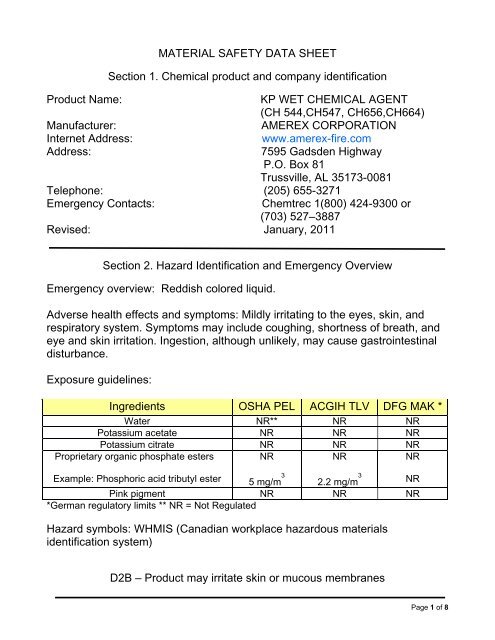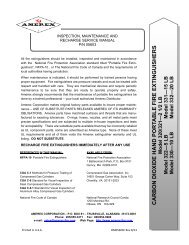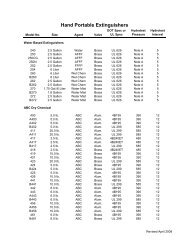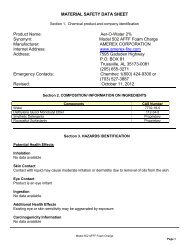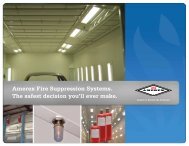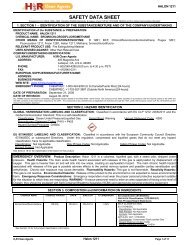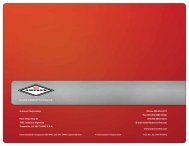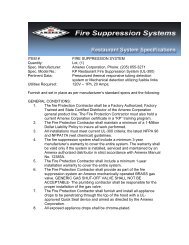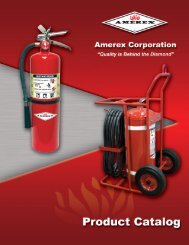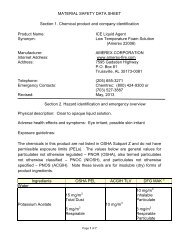KP WET CHEMICAL AGENT - Amerex Corporation
KP WET CHEMICAL AGENT - Amerex Corporation
KP WET CHEMICAL AGENT - Amerex Corporation
You also want an ePaper? Increase the reach of your titles
YUMPU automatically turns print PDFs into web optimized ePapers that Google loves.
MATERIAL SAFETY DATA SHEET<br />
Section 1. Chemical product and company identification<br />
Product Name:<br />
<strong>KP</strong> <strong>WET</strong> <strong>CHEMICAL</strong> <strong>AGENT</strong><br />
(CH 544,CH547, CH656,CH664)<br />
Manufacturer:<br />
AMEREX CORPORATION<br />
Internet Address:<br />
www.amerex-fire.com<br />
Address:<br />
7595 Gadsden Highway<br />
P.O. Box 81<br />
Trussville, AL 35173-0081<br />
Telephone: (205) 655-3271<br />
Emergency Contacts:<br />
Chemtrec 1(800) 424-9300 or<br />
(703) 527–3887<br />
Revised: January, 2011<br />
Section 2. Hazard Identification and Emergency Overview<br />
Emergency overview: Reddish colored liquid.<br />
Adverse health effects and symptoms: Mildly irritating to the eyes, skin, and<br />
respiratory system. Symptoms may include coughing, shortness of breath, and<br />
eye and skin irritation. Ingestion, although unlikely, may cause gastrointestinal<br />
disturbance.<br />
Exposure guidelines:<br />
Ingredients OSHA PEL ACGIH TLV DFG MAK *<br />
Water NR** NR NR<br />
Potassium acetate NR NR NR<br />
Potassium citrate NR NR NR<br />
Proprietary organic phosphate esters<br />
Example: Phosphoric acid tributyl ester<br />
NR<br />
5 mg/m 3 NR<br />
2.2 mg/m 3 NR<br />
NR<br />
Pink pigment NR NR NR<br />
*German regulatory limits ** NR = Not Regulated<br />
Hazard symbols: WHMIS (Canadian workplace hazardous materials<br />
identification system)<br />
D2B – Product may irritate skin or mucous membranes<br />
Page 1 of 8
Section 3. Composition/ information on ingredients<br />
Name/Compound Weight % CAS #<br />
Water < 50 7732-18-5<br />
Potassium acetate < 50 127-98-2<br />
Potassium citrate < 5 866-84-2<br />
Organic phosphate esters<br />
< 5 68130-47-2<br />
Example: Phosphoric acid tributyl ester<br />
Pink pigment, mono azo dyes
Section 5. Fire fighting measures<br />
Extinguishing media: non combustible and non flammable – product is an<br />
extinguishing agent<br />
Unusual fire/explosion hazards: in a fire this material may decompose, releasing<br />
oxides of phosphorus, carbon, and acetic acid (see Section 10).<br />
Insensitive to mechanical impact or static discharge.<br />
HMIS hazard ranking: health 1, flammability 0, reactivity 0, personal protective<br />
equipment: eye protection, gloves and appropriate skin protection (see<br />
Section 8)<br />
Section 6. Accidental release measures<br />
Large spills (one drum or more) should be addressed by hazardous materials<br />
technicians following a site-specific emergency response plan and trained in the<br />
appropriate use of PPE. Clean up released material using sorbent socks for<br />
containment, followed by sorbent material inside containment. If deemed<br />
necessary, wear full face APR or PAPR with organic vapor cartridges (Section<br />
8). Bag and drum for disposal. If product is used and/or contaminated, for<br />
example if mixed with kitchen grease, use PPE and containment appropriate to<br />
the nature of the mixture. Handle and dispose of as a hazardous waste unless<br />
testing indicates otherwise. Decontaminate with detergent and water.<br />
Section 7. Handling and storage<br />
Avoid skin, eye, or respiratory exposure. Use appropriate PPE when handling or<br />
maintaining equipment, and wash thoroughly after handling (see Section 8).<br />
Keep product in original container or extinguisher. Contents may be under<br />
pressure – inspect for extinguisher rust periodically to insure container integrity.<br />
Do not mix with other extinguishing agents.<br />
Page 3 of 8
Section 8. Exposure controls/ personal protection<br />
During the application of this product against fires, exhaust gases and the<br />
products of incomplete combustion (PICs) are the principal respiratory hazards.<br />
In the manufacture of extinguishers, automated systems and point source<br />
ventilation controls sufficiently minimize respiratory exposure. Employers and<br />
employees must use their collective judgment in determining occupational<br />
settings where the use of a respirator is prudent. The need for respiratory<br />
protection is not likely for short-term use in well ventilated areas.<br />
Respiratory protection: use air-purifying respirator (APR) or powered airpurifying<br />
respirator (PAPR) with organic vapor cartridges/canisters for short<br />
term exposure, and supplied air/SCBA for high concentration or prolonged<br />
exposure.<br />
Eye protection: wear chemical goggles.<br />
Skin protection: use nitrile, latex, or similar gloves and coveralls. Good personal<br />
hygiene practices essential, such as avoiding food, tobacco products, or other<br />
hand-to-mouth contact when handling. Wash thoroughly after handling.<br />
Section 9. Physical and chemical properties<br />
Appearance: reddish colored liquid<br />
Specific gravity: ~ 1.3<br />
Solubility: soluble in water<br />
Non –flammable<br />
Flash point: none<br />
Vapor pressure: < 10 mm Hg at room temperature<br />
pH: approximately 8.5<br />
Boiling point: ~ 300 o F<br />
No explosive or oxidizing properties<br />
Page 4 of 8
Section 10. Stability and reactivity<br />
Stability: stable<br />
Incompatibles: strong acids, strong oxidizers such as sodium hypochlorite<br />
(bleach), aluminum, polyurethane, and any wet, reactive material.<br />
Decomposition products: heat of fire may release carbon dioxide, phosphorus<br />
oxide, and acetic acid.<br />
Possibility of hazardous reactions: none<br />
Section 11. Toxicological information<br />
Acute toxicity:<br />
Potassium acetate LD oral rat: 3250 mg/kg body weight<br />
50<br />
Phosphoric acid tributyl ester LD oral rat: >1400 mg/kg body<br />
50<br />
weight Target organs in man: respiratory system, eyes, skin.<br />
This product is a mild irritant to epithelial tissue, and may<br />
aggravate dermatitis. Ingestion may cause gastrointestinal<br />
injury. No information was found indicating the product causes<br />
sensitization.<br />
Chronic toxicity: This product’s ingredients are not considered as “probable” or<br />
“suspected” carcinogens by OSHA, IARC, or ACGIH.<br />
Reproductive<br />
toxicity:<br />
This product’s ingredients are not known to have reproductive<br />
or teratogenic effects.<br />
Section 12. Ecological information<br />
Ecotoxicity: weak environmental toxin, specific negative effects unknown.<br />
Persistence/<br />
Degradability: moderate biodegradation in soil, rapid photolytic degradation in<br />
air<br />
Page 5 of 8
Bioaccummulation: extent unknown<br />
Mobility in soil:<br />
water soluble, slow to evaporate, may reach groundwater<br />
Section 13. Disposal considerations<br />
This product is not a RCRA characteristically hazardous or listed hazardous<br />
waste. Dispose of according to state or local laws, which may be more<br />
restrictive than federal laws or regulations. Used product may be altered or<br />
contaminated, creating different disposal considerations.<br />
Section 14. Transportation information<br />
This product is not a hazardous material under U.S. Department of<br />
Transportation (DOT) 49 CFR 172, and is not regulated by the DOT.<br />
When shipped in a stored pressure type fire extinguisher, and pressurized with<br />
a non-flammable, non-toxic inert expellant gas, the fire extinguisher is<br />
considered a hazardous material by the US Department of Transportation and<br />
Transport Canada. The proper shipping name shall be FIRE EXTINGUISHER<br />
and the UN designation is UN 1044. The DOT hazard class/division is 2.2 Non-<br />
Flammable Gas. Packing Group – N/A<br />
Section 15. Regulatory information<br />
International Inventory Status<br />
Some ingredients are on the following inventories<br />
Country (ies) Agency Status<br />
United States of America TSCA Yes<br />
Canada DSL Yes<br />
Europe EINECS/ ELINCS Yes<br />
Australia AICS Yes<br />
Japan MITI Yes<br />
South Korea KECL Yes<br />
European Risk and Safety phrases:<br />
Page 6 of 8
EU Classification: Xi. Irritant<br />
R Phrases: 36 Irritating to eye<br />
S Phrases: 26 In case of contact with eyes, rinse immediately<br />
with plenty of water and seek medical advice<br />
36 Wear suitable protective clothing.<br />
U.S. federal regulatory information:<br />
None of the chemicals in this product are under SARA reporting requirements or<br />
have SARA threshold planning quantities (TPQs) or CERCLA reportable<br />
quantities (RQs).<br />
State regulatory information:<br />
Chemicals in this product are not covered under specific State regulations, as<br />
denoted below:<br />
Alaska - Designated Toxic and Hazardous Substances: None<br />
California – Permissible Exposure Limits for Chemical Contaminants: None<br />
Florida – Substance List: None<br />
Illinois – Toxic Substance List: None<br />
Kansas – Section 302/303 List: None<br />
Massachusetts – Substance List: None<br />
Minnesota – List of Hazardous Substances: None<br />
Missouri – Employer Information/Toxic Substance List: None<br />
New Jersey – Right to Know Hazardous Substance List: None<br />
North Dakota – List of Hazardous Chemicals, Reportable Quantities: None<br />
Pennsylvania – Hazardous Substance List: None<br />
Rhode Island – Hazardous Substance List: None<br />
Texas – Hazardous Substance List: No<br />
West Virginia – Hazardous Substance List: None<br />
Wisconsin – Toxic and Hazardous Substances: None<br />
California Proposition 65: No component is listed on the California Proposition 65 lists.<br />
Page 7 of 8
Section 16. Other information<br />
This MSDS conforms to requirements under U.S., U.K., Canadian, Australian,<br />
and EU regulations or standards, and conforms to the proposed 2003 ANSI<br />
Z400.1 format.<br />
The information herein is given in good faith but no warranty, expressed or<br />
implied, is made. Updated by Lindsay R. Hill, CIH.<br />
Page 8 of 8


